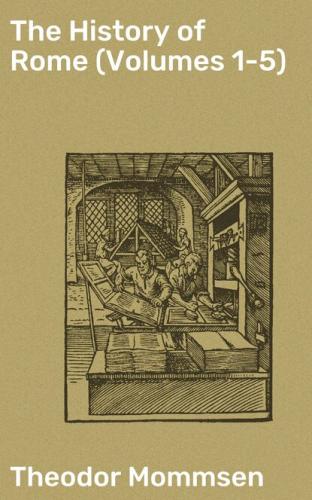The Etruscan religion occupied a higher level than the Roman, in so far as it developed at least the rudiments of what was wholly wanting among the Romans—a speculation veiled under religious forms. Over the world and its gods there ruled the veiled gods (-Dii involuti-), consulted by the Etruscan Jupiter himself; that world moreover was finite, and, as it had come into being, so was it again to pass away after the expiry of a definite period of time, whose sections were the -saecula-. Respecting the intellectual value which may once have belonged to this Etruscan cosmogony and philosophy, it is difficult to form a judgment; they appear however to have been from the very first characterized by a dull fatalism and an insipid play upon number.
Notes for Book I Chapter XII
1. I. II. Religion
2. This was, to all appearance, the original nature of the "morning-mother" or -Mater matuta-; in connection with which we may recall the circumstance that, as the names Lucius and especially -Manius- show, the morning hour was reckoned as lucky for birth. -Mater matuta-probably became a goddess of sea and harbour only at a later epoch under the influence of the myth of Leucothea; the fact that the goddess was chiefly worshipped by women tells against the view that she was originally a harbour-goddess.
3. From -Maurs-, which is the oldest form handed down by tradition, there have been developed by different treatment of the -u -Mars-, -Mavors-, -Mors-; the transition to -o (similar to -Paula-, -Pola-, and the like) appears also in the double form Mar-Mor (comp. -Ma-murius-) alongside of -Mar-Mor- and -Ma-Mers-.
4. The facts, that gates and doors and the morning (-ianus matutinus-) were sacred to Ianus, and that he was always invoked before any other god and was even represented in the series of coins before Jupiter and the other gods, indicate unmistakeably that he was the abstraction of opening and beginning. The double-head looking both ways was connected with the gate that opened both ways. To make him god of the sun and of the year is the less justifiable, because the month that bears his name was originally the eleventh, not the first; that month seems rather to have derived its name from the circumstance, that at this season after the rest of the middle of winter the cycle of the labours of the field began afresh. It was, however, a matter of course that the opening of the year should also be included in the sphere of Ianus, especially after Ianuarius came to be placed at its head.
5. I. IV. Tities and Luceres
6. I. VI. Amalgamation of the Palatine and Quirinal Cities
7. I. VII. Servian Wall
8. I. III. Latium
9. I. VII. Relation of Rome to Latium
10. I. V. Burdens of the Burgesses, I. XI. Crimes
11. The clearest evidence of this is the fact, that in the communities organized on the Latin scheme augurs and Pontifices occur everywhere (e.g. Cic. de Lege Agr. ii. 35, 96, and numerous inscriptions), as does likewise the -pater patratus- of the Fetiales in Laurentum (Orelli, 2276), but the other colleges do not. The former, therefore, stand on the same footing with the constitution of ten curies and the Flamines, Salii, and Luperci, as very ancient heirlooms of the Latin stock; whereas the Duoviri -sacris faciundis-, and the other colleges, like the thirty curies and the Servian tribes and centuries, originated in, and remained therefore confined to, Rome. But in the case of the second college—the pontifices—the influence of Rome probably led to the introduction of that name into the general Latin scheme instead of some earlier—perhaps more than one—designation; or—a hypothesis which philologically has much in its favour—pons- originally signified not "bridge," but "way" generally, and -pontifex- therefore meant "constructor of ways."
The statements regarding the original number of the augurs in particular vary. The view that it was necessary for the number to be an odd one is refuted by Cicero (de Lege Agr. ii. 35, 96); and Livy (x. 6) does not say so, but only states that the number of Roman augurs had to be divisible by three, and so must have had an odd number as its basis. According to Livy (l. c.) the number was six down to the Ogulnian law, and the same is virtually affirmed by Cicero (de Rep. ii. 9, 14) when he represents Romulus as instituting four, and Numa two, augural stalls. On the number of the pontifices comp. Staatsrecht, ii. 20.
12. It is only an unreflecting misconception that can discover in this usage a reminiscence of ancient human sacrifices.
13. I. XII. Nature of the Roman Gods
14. I. XII. Priests
15. -Sors- from -serere-, to place in row. The -sortes- were probably small wooden tablets arranged upon a string, which when thrown formed figures of various kinds; an arrangement which puts one in mind of the Runic characters.
16. I. X. Hellenes and Latins
17. I. VII. Servian Wall
18. I. II. Indo-Germanic Culture
19. I. IV. Tities and Luceres
CHAPTER XIII
Agriculture, Trade, and Commerce
Agriculture and commerce are so intimately bound up with the constitution and the external history of states, that the former must frequently be noticed in the course of describing the latter. We shall here endeavour to supplement the detached notices which we have already given, by exhibiting a summary view of Italian and particularly of Roman economics.
Agriculture
It has been already observed(1) that the transition from a pastoral to an agricultural economy preceded the immigration of the Italians into the peninsula. Agriculture continued to be the main support of all the communities in Italy, of the Sabellians and Etruscans no less than of the Latins. There were no purely pastoral tribes in Italy during historical times, although of course the various races everywhere combined pastoral husbandry,
